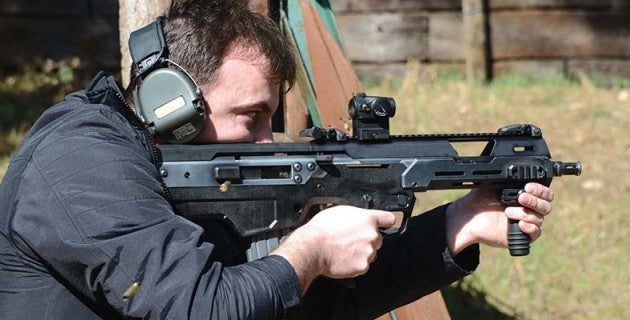The Small Arms Defense Journal website have published an article written by Leszek Erenfeicht describing the history and function of the MSBS Radon rifle, one of the major dark horses of 21st Century rifle designs. The Radon was designed from a clean sheet, ignoring previous Polish developments and attempting to draw from the best industry knowledge available. The rifle began as a collation of “good ideas” and was refined through hard work by the folks at Radon into something very much its own:
The Modular Small Arms System 5.56mm (Polish: Modulowy System Broni Strzeleckiej 5.56mm, MSBS-5.56) was initiated in December 2007, as a joint R&D program of the Warsaw-based Military Technology University’s (WAT) Department of Special Technologies with Radom’s Fabryka Broni.
The project aimed to develop, build and test a modular 5.56mm family of rifles within four years, up until 2010. Perhaps for the first time ever in the history of Polish arms design, the creators of the rifles polled a very wide circle of experts and end-users, both military and civilian, including the shooting media, for opinions concerning both the general layout and design details of the future Polish Army’s battle rifle.
…
How the Radon Functions
Although there seems to be little revolutionary stuff in the MSBS (as with most recent assault rifles), it’s the small details that make up the masterpiece. The designers applied for 7 patents and 11 utility models in the process. This article is the first time we are able to come up with any details.
 Norbert Piechota of FB heads the Radom design team developing the bull-pup variant explaining the finer points of the MSBS-5.56K fire control group.
Norbert Piechota of FB heads the Radom design team developing the bull-pup variant explaining the finer points of the MSBS-5.56K fire control group.
The 5.56mm MSBS-5.56 Radon rifle is an individual selective-fire, gas-operated weapon, in two basic configurations, the MSBS-5.56K/Radon-K (classical) and MSBS-5.56B/Radon-B (bull-pup). The Radon-K with its side-folding LOP-adjustable stock is the basic variant of the family. The bull-pup Radon-B shares the complete upper receiver with the K, substituting the B-specific lower receiver. Both rifles have the same internal design, while of course the B rifle is much more compact. Thanks to the modular design, each K rifle can be converted to a B rifle (and vice versa) in seconds as the barrels are exchangeable for different length or contour, and ejection direction can be changed at field-strip level. So far, that seems redundant, as even with the right side ejection, the bullpup rifle can be safely fired from the left shoulder. The brass flies downwards and to the front.
The Radon’s gas system uses a short-stroke piston traveling just 17 mm (.67-in). An operating rod transfers the impulse to the bolt carrier, which starts an automatic cycle, familiar to anyone who ever fired an external piston-driven AR platform. The main difference is that the return spring is placed within the upper receiver – enabling the stock to fold. The bolt locks always turning to the right, regardless of ejection direction.
The ambidextrous bolt catch paddles are placed on either side of the trigger guard, acting on a vertical bolt hold open shaft. The magazines are STANAG 4179-compatible, but in the most recent version an extended flared magazine well mouth would conflict with the Betamags – even though quad-row SureFire 60s and 100s would fit it for LMG work. The barrels are 6-groove, 1:7 inch RHT, as they are chambered for the STANAG 4172-compatible rounds. They easily change in the field (as opposed to QCB) thanks to a clever barrel vise installed inside the trunnion. That consists of two parallel wedges, set on the shared Roman-screw – no matter on which side of the trunnion it is turned (by hex key), the wedges move in reciprocating directions at the same time and rate, freeing or latching the barrel (actually held by the trunnion, the wedges just hold it there) without the need for torque-wrenches and all. How’s that versus the FN SCAR with eight screws to be turned in exact order and to exact torque? Several different profiles of the barrels were tested, in two lengths, 16 inches for the rifle and 12 inches for carbine, fluted and plain, with a thicker contour plain barrel planned for DMR or LMG variants.
We covered the Radon’s appearance at the 2015 SHOT Show back in January, and reported that Fabryka Broni, the manufacturer, is seeking to import the rifle to the United States. My overall impression of the weapon was highly positive, and I think with luck the Polish rifle will be successful on the international market.
 Your Privacy Choices
Your Privacy Choices
